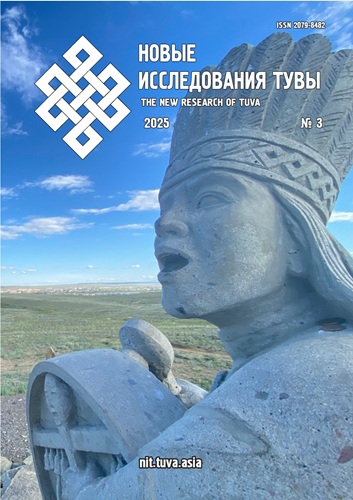The Functioning of Parcha in Early 20th Century Tatar Literature as a Compositional and Architectonic Form of the whole
DOI:
https://doi.org/10.25178/nit.2025.3.9Keywords:
Tatar literature; composition; architectonics; literary genre; lyrical miniature; landscape lyrics; wasf; parchaAbstract
The article offers the first scholarly investigation into the functioning of parcha in early 20th century Tatar literature as both a compositional and architectonic form of the whole. This analysis refines and deepens our understanding of the developmental trajectories of the genre-style system in Tatar national literature.
In a broad sense, parcha referred either to an excerpt from a larger work or to a miniature literary form. In the narrower sense, within the literature of this period parcha is presented specifically as a compositional and architectonic device. It is established that, as a compositional method, parcha generates a dynamic tension between openness and closure, completion and incompletion of the text. This activates the fragmentary logic traditionally associated with the "excerpt" genre in Russian and European literatures—one that emphasizes the inner boundlessness of the depicted world. Such patterns are evident in the poems of S. Ramiev and several miniatures by Dardmend.
The artistic and aesthetic potential of parcha as a value-bearing architectonic structure of the depicted world becomes manifest in miniatures that trace their generic origins to the descriptive section of the qasida (wasf), with its contemplative and landscape-oriented content rooted in a harmonious worldview. Poems of this type are characterized by compositional closure and precision in syntactic, rhythmic, and strophic boundaries. This is exemplified in Dardmend’s poems, G. Tukay’s ideal landscapes, and portrayals of nature in the lyrics of Sh. Babich.
The study identifies a core trend in the development of such miniatures, which preserve the “generic memory” of wasf: the gradual liberation from thematic, compositional, and stylistic conventions and the growing discovery of the immanent potential of their internal structure through interactions with other genres, non-generic forms, and types of discourse.
References
Averintsev, S. S., Andreev, M. L., Gasparov, M. L., Grintser, P. A. and Mikhailov, A. V. (1994) Categories of Poetics in the Change of Literary Epochs. In: Grintser, P. A. (ed.) Historical Poetics: Literary Epochs and Types of Artistic Consciousness. Moscow, Nasledie. 512 p. Pp. 3–38. (In Russ.)
Amineva, V. R. (2016) Gabdulla Tukay and 19th-Century Russian Literature: Typological Parallels. Kazan, Tatar Book Publishing House. 160 p. (In Russ.)
Amineva, V. R. and Mizhit, L. S. (2021) Subject-Image Structures in Tatar and Tuvan Poetry of the 1970s — 1990s. New Research of Tuva, no. 1, pp. 228–254. (In Russ.) DOI: https://doi.org/10.25178/nit.2021.1.13
Bakhtin, M. M. (1963) Problems of Dostoevsky's Poetics. Moscow, Sovetskiy Pisatel. 364 p. (In Russ.)
Bakhtin, M. (1975) Questions of Literature and Aesthetics: Studies from Different Years. Moscow, Khudozhestvennaya Literatura. 504 p. (In Russ.)
Bakhtin, M. M. (1979) Author and Hero in Aesthetic Activity. In: Bakhtin, M. M. The Aesthetics of Verbal Art. Moscow, Iskusstvo. 424 p. Pp. 7–180. (In Russ.)
Bakhtin, M. M. (2000) Freudism. The Formal Method in Literary Scholarship. Marxism and the Philosophy of Language. Articles. Moscow, Labirint. 640 p. (In Russ.)
Zagidullina, D. F. (2013) Modernism in Tatar Literature of the First Third of the 20th Century. Kazan, Tatar Book Publishing House. 207 p. (In Russ.)
Zaripova-Chetin, Ch. A. (2003) The Problem of Demonism in the Works of S. Ramiev in the Context of East European Aesthetics. Kazan, Master Line. 175 p. (In Russ.)
Kurbatov, Kh. (2005) Rhythmics of Tatar Poetry. Kazan, Institute of Language, Literature and Art, Academy of Sciences of the Republic of Tatarstan. 92 p. (In Russ.)
Losev, A. F. (1973) On the Concept of the Artistic Canon. In: Murian, I. (ed.) Problems of the Canon in Ancient and Medieval Art of Asia and Africa. Moscow, Nauka. 254 p. Pp. 6–15. (In Russ.)
Mizhit, L. S. (2009) The Tuvan Poetic Genre Ozhuk Dazhy (Three-Line Stanzas). Problemy vostokovedeniya, no. 1(43), pp. 88–93. (In Russ.)
Minnegulov, Kh. Yu. (1993) Tatar Literature and Eastern Classics: Questions of Interrelations and Poetics. Kazan, Kazan University Press. 384 p. (In Russ.)
Pospelov, G. N. (1983) Questions of Methodology and Poetics: Collection of Articles. Moscow, Moscow State University Press. 336 p. (In Russ.)
Reisner, M. L. and Ardashnikova, A. N. (2019) Persian Literature of the 9th — 18th Centuries, vol. 1: Persian Literature of the Pre-Mongol Period (9th — Early 13th Century). The Period of Canon Formation: Early Classics. Moscow, Sadra. 392 p. (In Russ.)
Sayapova, A. M. (2006) Dardmend and the Problem of Symbolism in Tatar Literature. Kazan, Alma-Lit. 246 p. (In Russ.)
A Comparative Poetics of National Literatures (2018) / Amineva, V. R., Ibragimov, M. I., Nagumanova, E. F., Khabibullina, A. Z.; scientific ed. by Amineva, V. R. Kazan, Kazan University Press. 236 p. (In Russ.)
Tamarchenko, N. D. (1997) The Russian Classical Novel of the 19th Century: Issues of Poetics and Genre Typology. Moscow, Russian State University for the Humanities. 203 p. (In Russ.)
Theory of Literary Genres (2011) / Darvin, M. N., Magomedova, D. M., Tamarchenko, N. D., Tyupa, V. I.; ed. by Tamarchenko, N. D. Moscow, Akademiya Publishing Center. 256 p. (In Russ.)
Fil’shtinskiy, I. M. (1985) History of Arabic Literature from the 5th to the Early 10th Century. Moscow, Nauka. 524 p. (In Russ.)
Khabibullina, A. Z. (2021) Elegy, Elegiac Mode and Elegism in Russian and Tatar Poetry: Criteria of Comparative Study. Kazan, RIC “Shkola”. 260 p. (In Russ.)
Sharipov, A. M. (2001) The Emergence and Formation of the System of Poetic Genres in Old Turkic and Turko-Tatar Literature (8th — 14th Centuries). Kazan, Kazan University Press. 364 p. (In Russ.)
Epstein, M. N. (1990) Nature, World, Universe’s Hidden Depths…: The System of Landscape Imagery in Russian Poetry. Moscow, Vysshaya Shkola. 303 p. (In Russ.)
Yusupova, N. M. (2018) The System of Symbolic Images in Tatar Poetry of the First Half of the 20th Century. Kazan, Ikhlas. 312 p. (In Russ.)
Published
How to Cite
For citation:
Amineva V. R. The Functioning of Parcha in Early 20th Century Tatar Literature as a Compositional and Architectonic Form of the whole. New Research of Tuva, 2025, no. 3, pp. 128-147 (In Russ.). DOI: https://doi.org/10.25178/nit.2025.3.9
Issue
Section

This work is licensed under a Creative Commons Attribution-NonCommercial 4.0 International License.

Author(s) license holder(s) grant rights for their work to the journal (grantee of a license) under the simple non-exclusive open license in accordance with Art. 1286.1 «Open license for a research work, work of literature or fine arts», Civil Code of the Russian Federation.
New Research of Tuva publishes articles under the Creative Commons Attribution-NonCommercial license (CC BY-NC).
Since it is an open license, author(s) reserve the right to upload the article to their institutional repository, submit it to another journal (if it allows republications), or republish it on their own website (in full, or in part).
However, several conditions apply here:
a) The republished version must always contain the name(s) and affiliation(s) of the author(s), the original title and the hyperlink to the original version on the New Research of Tuva website;
b) It must be in open access, free of charge, and no category of readers must be in any way whatsoever advantaged over general readership.
c) should the contribution be submitted elsewhere by its author(s) without substantial modification (30% or more of original text unchanged), the body of the article should contain a disclaimer that the original version was published in New Research of Tuva (with a link to the respective page)
The CC-BY-NC is a non-revocable license which applies worldwide and lasts for the duration of the work’s copyright.









